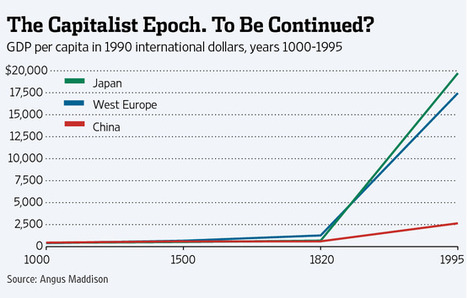 Source of graph: online version of the WSJ article quoted and cited below.
Source of graph: online version of the WSJ article quoted and cited below.
(p. A13) Angus Maddison, the late and eminent economist for the OECD, produced a famous chart in 1995, depicted nearby. For the longest time–basically from after the Garden of Eden until the 19th century–economic benefit for the average person in the West or Japan was flat as toast. The Mona Lisa aside, there was a reason someone back then said life was nasty, brutish and short. Then suddenly, new wealth spread broadly.
Maddison describes 1820 till 1950 as the “capitalist epoch.” He means that admiringly. The tools of capitalism unlocked the knowledge created until then. What came to be called “economic growth” gave more people jobs that lifted them and their families from the muck of joblessness and poverty. Maddison also noted that much of the world did not participate in the capitalist epoch. No wonder they revolt now.
This history is worth restating because the importance of strong economic growth, and the unavoidable necessity of a U.S. that leads that growth, may be disappearing down the memory hole of public policy, on the left and even among some on the right. Both share the grim view that the U.S. economy is flatlining, and the grim fight is over how to divide what’s left.
For the full commentary, see:
Henninger, DANIEL. “WONDER LAND; The Growth Revolutions Erupt; Ukrainians want what we’ve got: The benefits of real economic growth.” The Wall Street Journal (Thurs., Feb. 27, 2014): A13.
(Note: the online version of the commentary has the date Feb. 26, 2014.)
One of Maddison’s last important books was:
Maddison, Angus. Contours of the World Economy, 1-2030 AD: Essays in Macro-Economic History. Oxford and New York: Oxford University Press, 2007.

